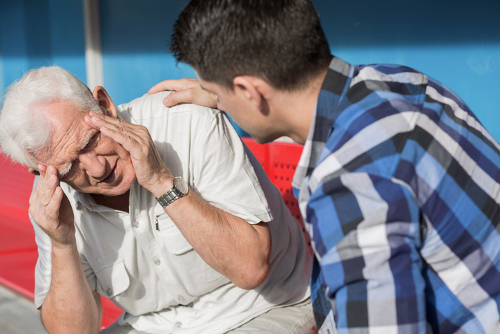
Credit: iStock.com/KatarzynaBialasiewicz
I was waiting to pick up my son at school when I saw a kid playing with a toy maze. You know the one I’m talking about? The plastic disc with small metal balls that you have to get into a groove in the center.
As I was watching him, I suddenly thought about benign paroxysmal positional vertigo (BBPV).
Completely random, right? And yet, there is a link.
A few days ago, I attended a medical conference, where I saw an interesting presentation on BPPV.
What Is Benign Paroxysmal Positional Vertigo (BPPV)?
It’s a very common type of vertigo (dizziness) where, for a brief moment, you feel that your head is spinning, or the world is spinning. The dizziness may be accompanied by a loss of balance, nausea, and vomiting.
The condition is a mechanical problem of the inner ear, and is usually triggered by a change in the position of your head.
Doctors haven’t figured out why this happens, but some calcium carbonate crystals in the inner ear become dislodged and float into another part of the inner ear called the vestibular labyrinth. This is a tiny, maze-like structure that is made up of three loop-shaped, fluid-containing tubes.
The presence of the dislodged crystals in these loops is what causes the dizziness. To get rid of the dizziness, all you need to do is get these crystals out of the tubes.
How to Get the Crystals out of Your Ears
There is a device called the “Epley” chair that is designed to do just that! The patient gets strapped into the chair, with their head held in position. The chair then tilts in different directions—forward, backward, sideways, upside down. By the time the chair comes back to its starting position, all the crystals would be maneuvered out of the curved tubes.
The problem is, not everyone has access to these specialized chairs. But, the good news is that you can replicate the effect of the chair by doing the “Epley” maneuver—a series of head movements—at home.
But before you start doing any of these moves, please see a specialist to confirm you have BPPV, and not something else. Once the diagnosis is established, the specialist will determine which ear is affected, and suggest the right movements needed to help you get the crystals back in position.
So, if you or anyone you know has BPPV, remember that reversing the symptoms is all about making the right moves. Quite like that toy maze.
Sources
Xiang-Dong, G., “Benign paroxysmal positional vertigo,” Journal of Neurosciences in Rural Practice, Jan. 2011; 2(1):109-110; https://www.ncbi.nlm.nih.gov/pmc/articles/PMC3122990/, last accessed July 31, 2017.
“Benign paroxysmal positional vertigo (BPPV),” Mayo Clinic, May 28, 2015; http://www.mayoclinic.org/diseases-conditions/vertigo/basics/definition/con-20028216, last accessed July 31, 2017.
Fauquier ENT, “Epley Maneuver to Treat BPPV Vertigo,” September 27, 2014; https://www.youtube.com/watch?v=9SLm76jQg3g
University of Colorado Denver, “Carol Foster, MD Vertigo Treatment Oct 11,” October 14, 2013; https://www.youtube.com/watch?v=mQR6b7CAiqk
SLUCare, “Epley Omniax Treats Dizziness at SLUCare Clinic,” July 28, 2014; https://www.youtube.com/watch?v=cA3W35RlZYQ
